

An AT-9 "Jeep" Crashed on the W.H. Outlaw Farm6, September 11, 19423
|
|
The Men Who Died |
|
Captain Dallas "Dal" Lester Morris1 (Aug 26, 1914-Sep 11, 1942) was the seventh of ten children of James Lester (1878-1938) and Elizabeth Henrietta "Etta" (née Biggers) (1877-1951) Morris of Charlotte, NC.
|
|
Chaplain (First Lieutenant) Lawrence Aloysious Gough2 (abt 1912-Sep 11, 1942) was second of five children of Lawrence Aloysious (1881-1953) and Anna V. (née Tomkins) (1887-1951) Gough of New York, NY. Lawrence Gough was second-generation Irish-American and grew up in a mixed-immigrant neighborhood. A 1937 graduate of St. Joseph's Seminary (right), Yonkers, NY, Chaplain Gough had been a pastor of Immaculate Conception (St. Mary's) before entering service in early 1942. At the time of his death, he was assigned to Moody Field, and was one of 40 Army chaplains who had died before the war reached its one-year anniversary. He was beloved in New York and he received full military and religous services to an overflow crowd of dignitaries and well-wishers before interment at St. Mary's Cemetery. |
|
The Airplane7 that Crashed |
|
The Curtiss-Wright AT-9 was a trainer designed to teach pilots to fly dual-engine aircraft, particularly the Lockheed P-38. With a wingspan of 40 ft, it was 31 ft long and nearly 10 ft tall. High-powered (2 ~300 hp engines), it was capable of a speed of nearly 200 mph. This "hot rod" was liked by many pilots, but its instability led some to say that the P-38 should have been used as a trainer for the AT-9. Perhaps my favorite comment about this aircraft is "if you lose one engine, you can use the other to fly to the crash site." About 800 were manufactured; surplused craft were not sold to the commercial market because of the difficulty in flying it. In a personal communciation (2014-02-22), J.V. Vinyard (AT-9 pilot and correspondent for the now-dissolved Hump Pilot Association) wrote "It is true that the AT-9 was a tricky aircraft to fly. It certainly would have been the last aircraft anyone would [have] wanted to get into a thunderstorm with." Two exist today: one is a composite and one is partial (1 , 2) |
|
Accounts of the Crash |
|
The Incident Report4, summarized below with included images to the right, was 25 pages long, but most of it was irrelevant to the purposes of these pages (e.g., 2 pages of duplicate sparse press releases; 4 pages correcting the regulation number of previous submissions; routing slips . . . .) My editorial comments are preceded by "WHO,"
and, as usual, direct quotes taken from others are indicated.
[WHO: Possibly, para 1 is a summary added later to the report?] [WHO: the stated take-off time of 2100 is obviously incorrect, because it crashed about 1715. This mistake might have given rise to the reference on the www as a "night-time crash." See para 4 below, for example.] [WHO: The airplane must have crashed coming from the eastnortheast, not the northwest. Thus, the plane hit the ground, as stated, about 75 yards from the residence, and (a) an airplane seat was later found to the west in the bay (see Recollections of Sam Watson); (b) the fence damaged was presumably on the east side of the bay (See Recollections of Christine Outlaw); and (c) a jawbone was embedded in a tree (see Recollections of Addie Watson), and from my private notes, not shown, I have recorded from her conversation: "a part of a jawbone was embedded in a tree on the west fencerow." The fence row, a portion of which still stands, is about 100 yards to the west of the crash site, consistent with the stated extent of the debris field.] [WHO: Most accounts, like this one, indicate Mrs. Wetherington was home at the time of the crash, but did not hear it because of the violent weather. The Nashville Herald, however, indicates the Wetheringtons were away at the time of the crash.] [WHO: The description of the violent updraft that caused the plane to stall and spin is significant, cf. para 2, above, and consistent with Mrs. Courson's testimony, para 4, above.. The location of the bodies "a considerable distance from the major portion of the airplane" is in corroboration of Granny Watson's statement about location of human remains.] [WHO: As Moody is nominally 25 miles from the crash scene, I did not transcribe a moment by moment blow of the conditions.] [WHO: Error in timing again. The crash occurred at about 5:15 pm, not 15:15 (whatever that is).] |
|
|
|
|
|
|
|
|
|
|
|
|
|
|
|
Recollections of my mother, Christine W. Outlaw (1918-2001), written Jan 9, 19935: "Today, I went out to Lovein Funeral Home. Mrs. Ruby Wetherington (90) died Thursday. Funeral today. Mrs. Wetherington & her family lived on our farm for a few years. When her husband went to do defense work, they moved. His health was not good for farming. They were living on our farm in 1941 [WHO: should read: 1942] when a plane got in a storm & crashed from Moody Air Force Base. A pilot & chaplain were killed. We thought lots of the Wetherington family. Mrs. Wetherington called us the night the plane fell. At that time we were living in Lenox, Ga, where my husband, W.H. Outlaw, was principal of the school. Mrs. Wetherington’s son went out to feed the mules. Instead of opening the gate, he climbed the fence & spotted something (plane) in the old cucumber patch. Cukes were finished & the patch was grown up in weeds. The weather was real bad [so] they did not hear the noise. She went out & discovered it was a plane & notified the Sheriff’s office. This was late one Friday afternoon. We came down Saturday. You have never seen so many people. Moody closed the roads & guarded the area until all remains etc. were gathered. Several wanted my husband to file suit, which was the least of his thoughts. We were very sorry it happened. Moody filled the hole & replaced the fence that was destroyed. We did not ask for this. Two men were dead & plane was gone. "Later the men’s families came to see where they died."
|
Newspaper accounts: Nashville Herald8 (left) and unknown (right)
|
|
Artifacts from the Crash Remaining after the Military Clean-up |
|
Oral Recollections of my grandmother, Addie F. Watson (1898-1985), as told to to William H. Outlaw Jr. (1946-) and as told to Samuel L. Watson (1923-2004) via Tommy W. Watson (1956-): Granny told me that she and two women searched the field after the military left. They found pieces of human remains and buried them. They also found (part of ) a jawbone embedded in a tree; they dug the jawbone out and buried it too. I do not remember whether she identified the other women, and I do not remember whether she identified the burial site. Unaware of my knowledge, Tommy Watson also indicated that Granny Watson had told Sam about the jawbone at some time. Oral Recollections of my uncle, Samuel L. Watson (1923-2004), as told to Larry S. Watson (1950 -) Larry Watson recalled that his father told him of finding an aircraft seat in the bay just to the west of the crash site.Recollections of Alton Rowan (abt 1925-) as told to William H Outlaw Jr (1946-): In October, 2008, Alton Rowan--unaware of my previous knowledge--related accounts of the crash to me. Immediately after the crash, his family ( headed by stepfather Saron Parr) visited, planning their move into the farmhouse as the Wetheringtons were moving out. He mentioned bits of human remains (in his words, "guts and skin") scattered over a large area and elaborated on the presence of blowflies. He also mentioned that one seat was leaning up against a tree (likely, that to which Sam alluded, above). This was also the general area that my grandmother described a jawbone being embedded in a tree. (see above). My direct knowledge: When a young man, I found a mangled watch in the debris field. I placed the watch on the mantel inside the unoccupied farmhouse (at which time was used by my parents as an afternoon retreat). It was removed by parties unknown, very much to my regret then and now. I do not know that it belonged to the victims, but I suspect so, and now whether is unknowable. On Feb 19, 2014, while working on Sutton Vineyard, I found a piece of crumpled rivetted aluminum. The location was 65 yards from the center of the location of the old farmhouse on a bearing of approximately 13o, i.e. the site of the impact, within error. I believe that this finding is a part of the aircraft, but the area is not pristine. It was farmed from the time it was cleared (shortly after 1885 by my greatgrandfather Jerry S. Sutton until 2003 when I decided to let it go fallow). Also, it was found 20-25 feet from temporary staging area for waste from a barn demolition. To the best of my knowledge, nothing stored under the barn or used in farming could have produced this artifact. If the enquiries I have made to aviation restorers and historians alter or substantiate this viewpoint, this page will be editted. The location is marked on the ground.
|
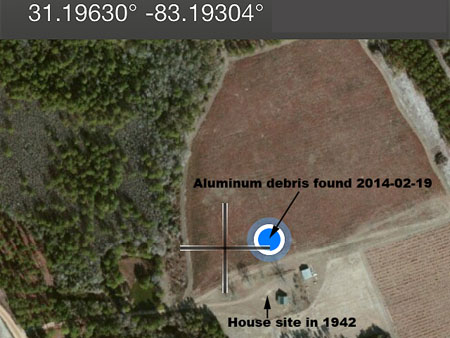 |
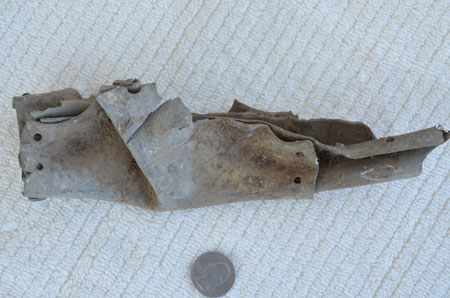 |
|
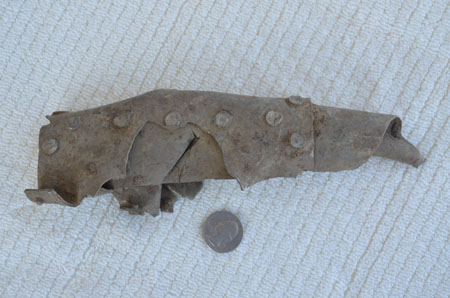 |
|
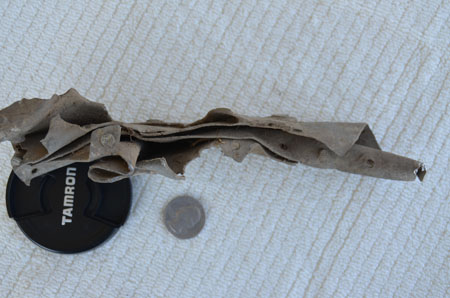 |
|
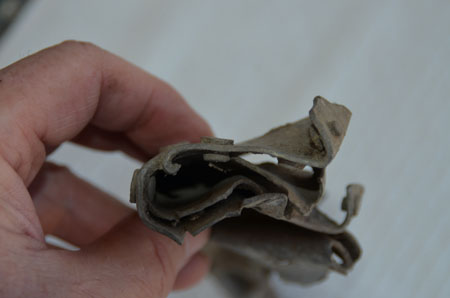 |
|
Footnotes Unless otherwise noted, the links were accessed or confirmed in February and March, 2014. I never finish anything, so edits might come later, pending substantive new information. 1 The image of his marker was taken from Billion Graves, and I reworked it for presentation here. Some bibliographic information was sourced from Find A Grave and Ancestry.com. Three of the linked images are from Wake Forest's yearbook, the Howler (for which I thank Vicki Johnson (pers com, 2014-02-24) of the Z. Smith Reynolds Library). I am especially grateful to Susan Grills (pers com, 2014-03-01) of Charlotte, who directed me to the Gold Star Veterans Exhibit at the Charlotte-Mecklenburg Library. For background information, I used Bynum Shaw's The History of Wake Forest University, v. 4, 1988, Wake Forest University. 2One image and bibliographical information was from Ancestry.com, including historical documents and member-posted items. Some bibliographic information and the main image was from the Herald Statesman (Yonkers), which ran a front-page article the day after his death and later a front-page article on his services (the latter linked), and from the Daily Argus. 3At least one other Moody-Field aircraft crashed in Berrien County with loss of life during the war. Thus, Carolyn (née Peters) Griffin (pers com, 2011-10-07), indicated that one pilot was lost in the crash on the E.J. Nix place. (mfr who crash on McMillan farm during ww2 tba) 4The Incident Report was obtained from Michael T. Stowe. 5For the full set of her recollections, click here. 6 The W.H. Outlaw Farm, which I name after my father because of his childhood there, his trials in keeping it during the depression, and his passion for it, is a State of Georgia Centennial Farm (click here for presentation of award by Commissioner of the Georgia Department of Natural Resources Mark Williams, left, and Georgia Secretary of Agriculture Gary Black, right). In brief, part of the farm was owned by my 3d greatgrandfather John Ellis Connell before the war. More recently, all of it has been in my direct unbroken line of descent since 1885 (the Buck Sutton Old Place) and 1905 (a portion of the Samuel Washington Watson Place). For details, click here. 7For a concise summary, click here or see Wikipedia, as I did for the image. 8Skeeter Parker is thanked for the Nashville Herald clipping; the other, unidentifed, was in my mother's estate. |
|
Return to Documentation for this page. |
|